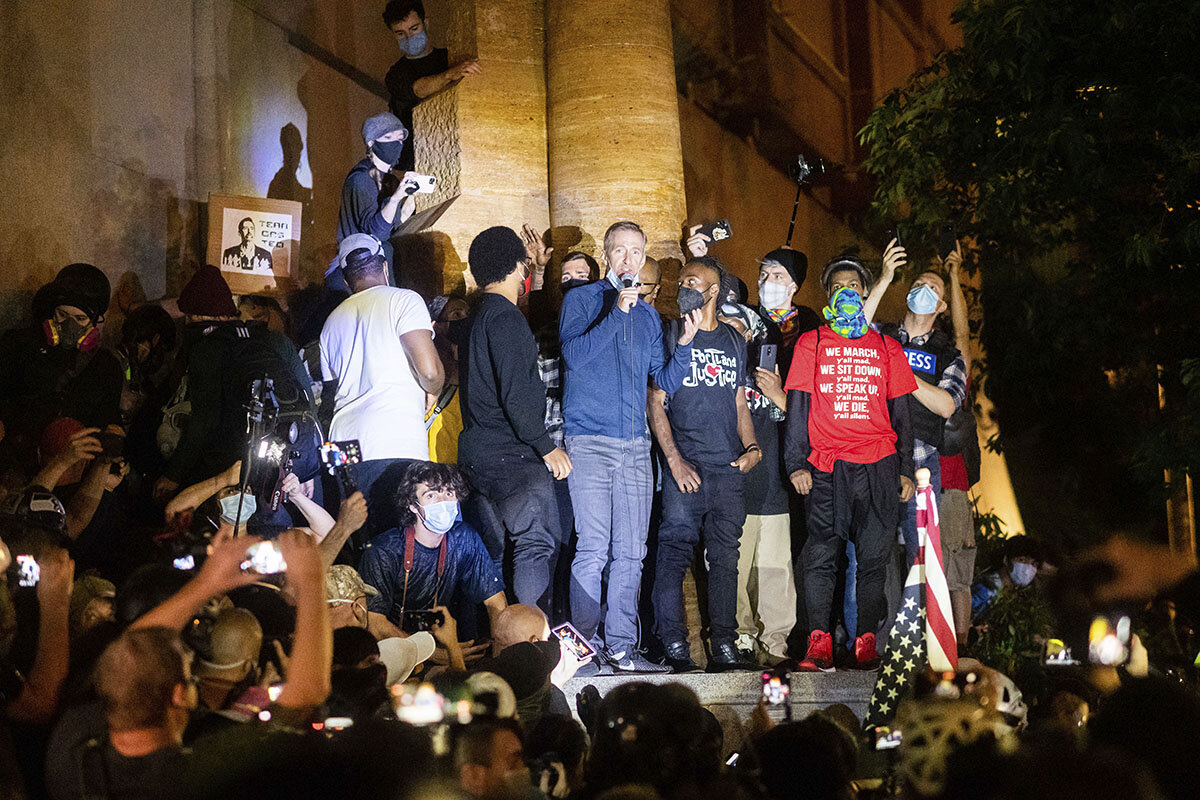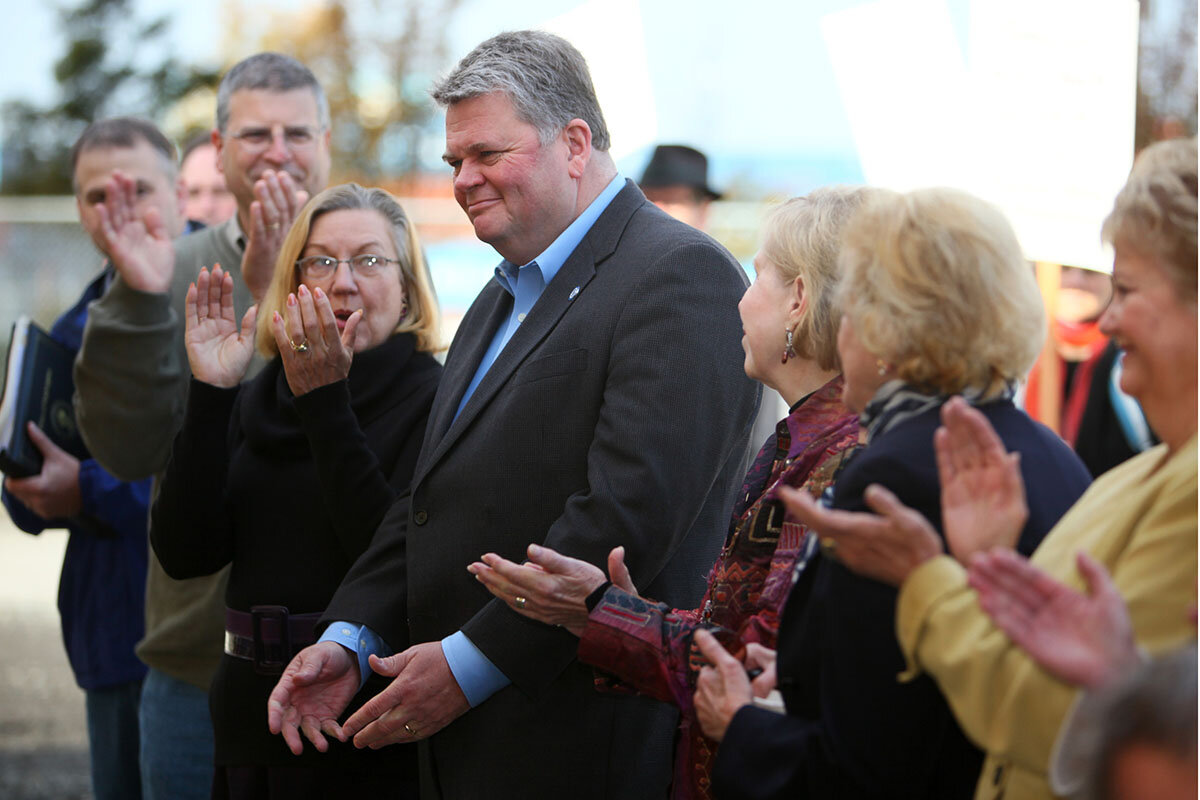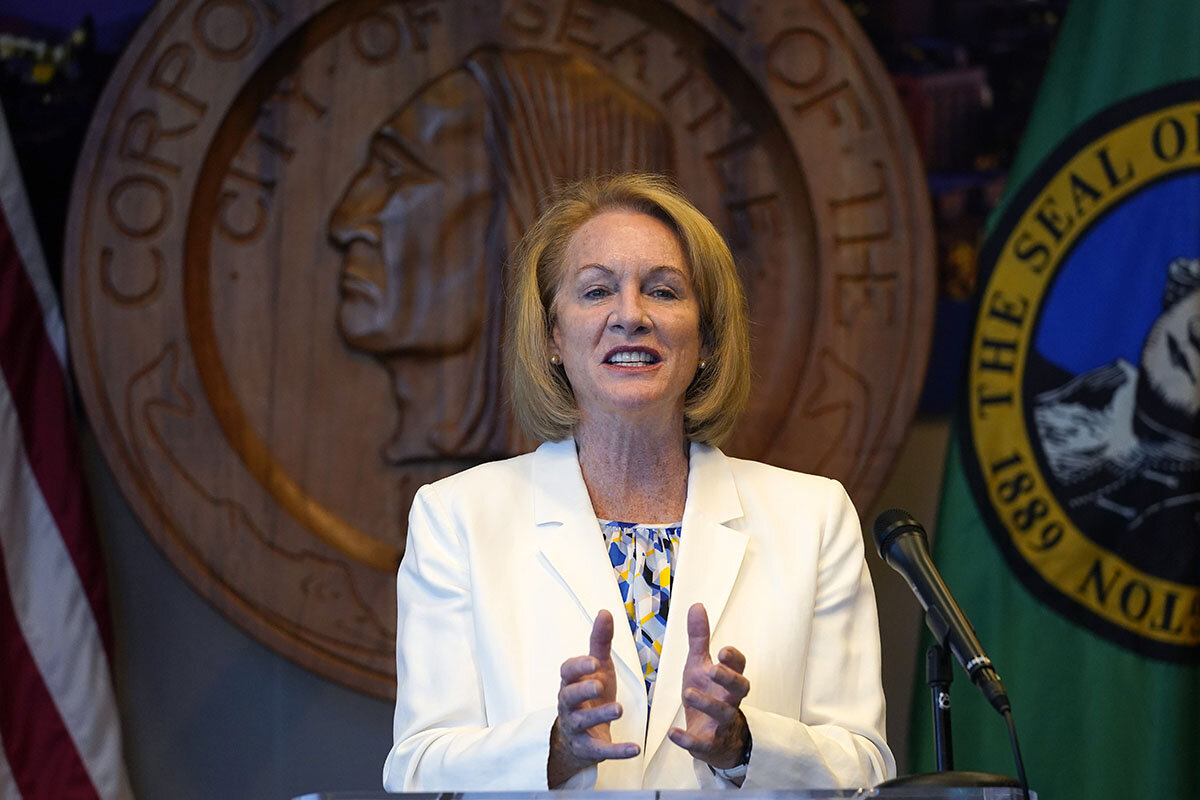Free assembly vs. public safety: US mayors making it work
Loading...
| Portland, Ore.; and Austin, Texas
Portland Mayor Ted Wheeler has been getting it from all sides.Ā
After more than 80 days of over racial injustice and policing, one of the cityās biggest real estate developers emailed the mayor and his City Council colleagues last month, warning about businesses leaving because of the ālawlessness you are endorsing downtown.ā Many businesses in the city core are still boarded up ā and now shrouded in smoke from wildfires.Ā
Over the summer, protesters against police brutality and racial injustice sporadically demonstrated at the mayorās condominium. When a large crowd broke windows, sprayed graffiti, and set fires at his building on Aug. 31, he announced heād be moving. Ā
Why We Wrote This
Long months of civil disorder belie progress some U.S. mayors are making on reforms demanded by protesters and in best practices for dealing with the protests themselves.
As Alison Gash, a Portlander and political science professor at the University of Oregon, puts it: Mayor Wheeler is āin a tough spot.ā
And so are mayors nationwide, as they grapple with concerns about police brutality and systemic racism during a sharply divided presidential election season. Itās a tricky balancing act ā guaranteeing constitutional rights to free speech and assembly, while maintaining public safety when demonstrations turn violent or destructive.
After a summer of protests, rage is still flowing, from , where demonstrators were arrested this week for vandalism and rioting after a police shooting, to Los Angeles, where a gunman shot two sheriffās deputies in their patrol car on Saturday. At the hospital where the deputies were being treated, ādeath to the policeā ā which LA Mayor Eric Garcetti called āabhorrent.ā
While mayors set a tone and are targeted by protesters ā indeed, protesters have set upon not just Mayor Wheelerās residence but Mayor Garcettiās and those of mayors in St. Louis, Chicago, Seattle, and Pittsburgh ā the power of mayors is relatively limited, from a legal perspective at least, in many cities.Ā
But despite the costliest civil disorder in U.S. history, four months into the protests, some cities are making progress on both the reforms demanded by protesters and in best practices of dealing with the protests themselves.Ā
Burning mattresses obscure progress
For example, in Portland, late-night confrontations with law enforcement, a July showdown with federal forces, and the fatal shooting of a man affiliated with a right-wing group by a self-proclaimed anti-fascist on Aug. 29 have obscured progress on racial justice, says Christopher Shortell, a political science professor at Portland State University.Ā
That progress includes a series of police accountability measures passed by the Oregon Legislature in June, and a $62 million fund for āBlack Relief and Resiliencyā to support Black individuals, nonprofits, and businesses especially hard hit by the pandemic.Ā Portland is discontinuing the use of armed police officers in high schools and redirecting some police funds to communities of color.
āConstant political pressure is what has led to continued attention by elected officials, but that doesnāt get noticed because itās a lot more dramatic to see the mattress thatās burning,ā says Professor Shortell. He cites a āsignificant disconnectā between the national portrayal of Portland engulfed by chaos and the actuality of very localized, late-night clashes with law enforcement.
The key for city leaders managing these situations, say mayors and observers, is real, noticeable reform, and strong communication with the public and stakeholders, including law enforcement.
āItās the external relationships, the dealing with the community, the media and so on, being seen as listening and acceptable, thatās the job of the mayor,ā says Mark Funkhouser, a former mayor of Kansas City, Missouri. āItās a very difficult job.ā
When Greg Nickels became mayor of Seattle in 2002, it was just overĀ a year after violent clashes between 50,000 protesters and police had overwhelmedĀ the city during the World Trade Organizationās Ministerial Conference. He was intent on ensuring the city never went through that again, the former Democratic mayor recalls.
He talked with his police chief about having officers in crowds to prevent mobs from forming, instead of in riot gear separated from the crowd. Before protests they would set clear ārules of engagementā for protesters: Free speech and civil disobedience rights would be respected, but unlawful behavior would not be tolerated.
In his seven years as mayor, Mr. Nickels says there were about 30 marches and protests ā mostly about the Iraq War and immigration ā and only one arrest.Ā
āWe need to protect that free speech, but we have to build a little box around it that if thereās illegal action we have to deal with it,ā he adds.
Mr. Nickels never would have turned over a portion of Seattle to āvigilantesā ā whether of the right or left ā referring to the āChopā occupation (Capitol Hill Organized Protest)Ā over the summer, he says. In early June, protesters staked out a six-block area around the Seattle Police Departmentās East Precinct headquarters.
Old-fashioned tool: Listen to protesters
But Mayor Jenny Durkan and then-Police Chief Carmen Best immediately began talking with protesters.
The city met some protester demands on policing, for example by restricting the use of crowd-control munitions. Ms. Durkan also dispatched a team to negotiate plans to facilitate traffic and rescue in the protest zone, shrinking the footprint while activism and street art continued. African American community leaders stepped in as violence in the zone escalated along with community complaints, and gradually protesters began to depart until only a small group remained around the precinct building. On July 1, police moved back in with limited opposition.
That old-fashioned tool ā listening to protesters and acting on their concerns ā is also a way to prevent violent protests.
Austin, Texas, has seen protests against police brutality and racial inequality after the Minneapolis police killing of George Floyd in late May. Though there have been a few incidents of violence and vandalism, the protests have been almost entirely peaceful.Ā
And Austin officials have begun to respond to protestersā demands, including ātrying to reimagine policing as a component of public safety,ā says Steve Adler, the cityās mayor.
Most notably, the City Council last month passed a new budget that could reallocate tens of millions of dollars of police funds and functions to other city departments. One $80 million fund could see primarily civilian functions like forensics and victim services ādecoupledā from the department.Ā
āThose are targeted, constructive things to do consistent with what our community wants us to do, freeing up time for our police to focus on real crime,ā says Mayor Adler.
But with the protests and debate over police reform politicized by conservatives and progressives, mayors like Mr. Adler find themselves struggling to cut through the heated rhetoric.Ā
In Austin, progressives celebrated the new budget as a $150 million reallocation of police funding, while conservatives ā including Greg Abbott, the stateās Republican governor ā criticized it as a $150 million strike to ādefund the police.ā Both are technically wrong. Only about $20 million of the cuts are immediate, with the rest potentially being redirected in the future, and no clear timeline for if or when those funds will be redirected.
Mayor Adler, a Democrat, says rhetoric focusing on violence distracts from the main grievances of the protesters, along with other important issues like the countryās response to the pandemic.
āAs we approach November, I think weāre going to hear more arguments that are intended to distract us from those kinds of issues by raising issues that would suggest that cities arenāt safe, or that mayors donāt care about safety,ā says Mayor Adler.
On Sept. 2, President Donald Trump asked the Justice Department to develop a list of āanarchist jurisdictionsā the federal government should seek to withhold funding from, a move criticized by major city mayors around the country as unlawful and intentionally divisive.
In the meantime, Mayor Wheeler announced heās shedding some of his portfolio so he can focus on āextreme challengesā facing the city. Last week, he directed police not use one kind of tear gas, in part because it is seeping into peopleās homes. But police noted they used it āsparinglyā in ālife-safetyā events.
In many cities mayors act mostly as the head of the city council and have limited ability to take policy or executive actions themselves. Day-to-day operations ā including public safety ā are the purview of city managers.
Even Mr. Wheeler, who is in effect the police commissioner, had to set up a new process to put three suspect police officers on administrative duty last week because the independent review board is so backed up with complaints, explains Professor Shortell.
And for most mayors, particularly ones of medium and small towns, there hasnāt been much rioting or looting to deal with. One analysis by the U.S. Crisis Monitor found that in over 10,000 protests between May 24 and Aug. 22, approximately 5% involved violence.
And yet the cost of damage from vandalism and looting in protests across 140 cities after the May 25 death of Mr. Floyd has been significant ā between $1 billion and $2 billion from May 26 to June 8, according to the Insurance Information Institute.ĢżĢż
Professor Shortell reminds that policy changes come more slowly than the public wants. Indeed, a recent survey by the Portland firm DHM Research found that a majority of Oregon voters disapprove of how elected leaders ā President Trump, Oregon Democratic Gov. Kate Brown, and Mr. Wheeler ā have responded to protests in the United States and Oregon.
Itās also hard to sustain pressure for change. Protests that were thousands strong in Portland dwindled to hundreds, and the daily early evening ānonviolent protestā at Pioneer Courthouse Square downtown stopped being scheduledĀ after Labor Day.Ā
While the police have not reported any violent clashes and arrests since Sept. 8, Sgt. Kevin Allen, a spokesman for the Portland Police Bureau, wrote in an email to the Monitor that poor air quality from wildfires may have discouraged protesters.
But heās fairly certain about one thing: āWe do anticipate more demonstrations will be coming leading up to the election.ā
Staff writer Ann Scott Tyson contributed to this report from Seattle.ĢżĢż






